Ancient Aqueducts of Turkey: History, Engineering, and Top Sites to Visit
Ancient aqueducts in Turkey are among the rare examples of engineering genius dating back thousands of years. These water structures dating back to the Roman and Byzantine periods both reveal the historical texture of Anatolia and shed light on the lifestyles of ancient cities. From Istanbul to Antalya, Denizli to Izmir, these magnificent aqueducts are not only historical artefacts but also provide unique information about urban planning, water engineering and the cultural richness of the period.
For travellers wishing to visit ancient aqueducts in Turkey today, these structures are fascinating stops for both archaeological discovery and cultural tourism. While famous structures such as Valens Aqueduct, Aspendos Aqueducts, and Hierapolis Waterways are the most impressive examples of ancient water systems, the ruins in lesser-known regions such as Pergamon, Side, Aizanoi are like hidden treasures waiting to be discovered.
In this article, we take a detailed look at the history of ancient aqueducts in Turkey, their cultural and mythological contexts, their current status, transportation and visiting tips, places to visit and much more. This guide to ancient aqueducts will be an ideal resource for both history buffs and cultural travellers.
(Image Source: Türkiye Kültür Portalı)
History and Importance of Ancient Aqueducts in Turkey
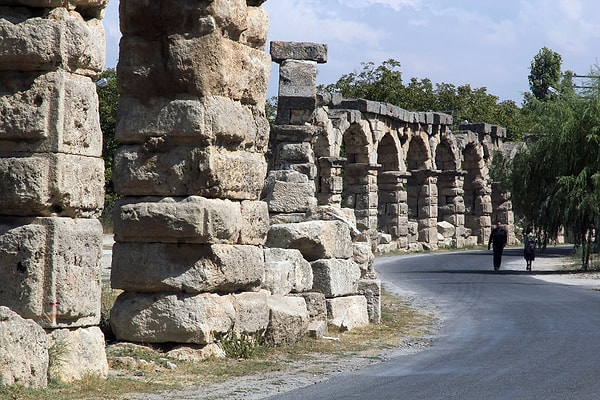
Ancient aqueducts in Turkey generally date from the Roman and Byzantine periods. Aqueducts were built in many different regions of Anatolia, especially during the periods when the Roman Empire was strong, to meet the water needs of the cities. These aqueducts enabled clean water to be transported over long distances to city centres.
For example, the Valens Aqueduct (Bozdogan Arch) in Istanbul was built in the 4th century and is connected to a water network of about 250 kilometres long to meet the water needs of the city. This aqueduct is one of the masterpieces of Roman engineering, and some parts of it are still standing today.
The Aspendos Aqueducts in Antalya are one of the most important water structures of the Roman period and fascinate visitors with their still-standing arches. The Hierapolis Aqueducts near Pamukkale are also an integral part of the region's water system.
Cultural and Mythological Context
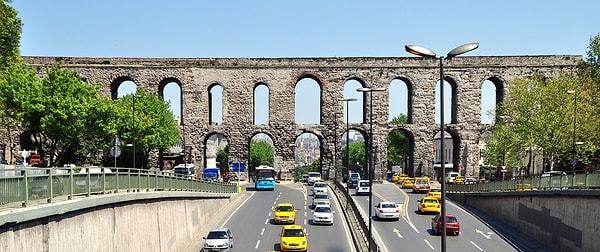
Ancient aqueducts are not only engineering marvels but also closely related to the culture and belief systems of the period. Water was regarded as the source of life in ancient civilisations, and bringing water was considered a sacred duty for the prosperity of cities. Some aqueducts are associated with water gods or local legends.
For example, the aqueducts near the ancient city of Ephesus are integrated with the sanctity of the Temple of Artemis. In addition, legends believed to have taken place during the construction of some aqueducts tell of the sacrifices of the workers who laboured in the construction of the structure.
1. Valens Aqueduct (Istanbul)

Valens Aqueduct is the largest and best-preserved ancient aqueduct in Istanbul. Built by the Roman Emperor Valens in the 4th century, it was also used during the Byzantine and Ottoman periods. The arch, which is approximately 970 metres long, once stretched from Haydarpaşa to the centre of the city to meet the city's water needs.
Transport: It is located on Atatürk Boulevard in the Fatih district of Istanbul. It is easily accessible by public transport.
Places to See in the Near Neighbourhood: Historical sites such as Hagia Sophia, Blue Mosque, and Basilica Cistern.
Activities: Exploring the historical peninsula, walking tours, and visiting the surrounding museums.
2. Aspendos Aqueducts (Antalya)
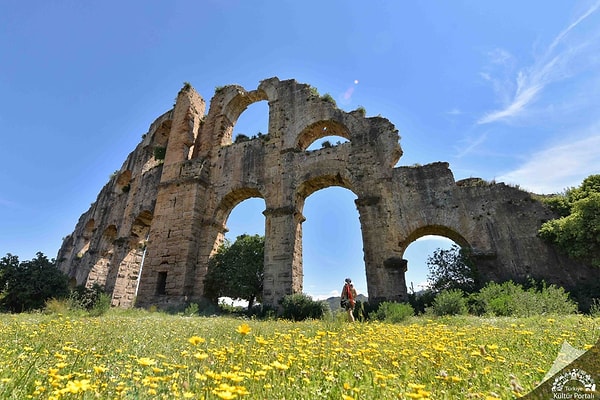
The aqueducts of the region, famous for the ancient theatre of Aspendos, are unique examples of Roman engineering. The arches, which bring water about 15 kilometres long, were skilfully built in mountainous terrain.
Transportation: Aspendos from the centre of Antalya can be reached in about 45 minutes by car.
Places to see in the immediate vicinity: Aspendos Ancient Theatre, Perge Ancient City, Manavgat Waterfall.
Activities: Attending cultural events in the ancient theatre, nature walks, and picnics by the river.
3. Hierapolis Aqueducts (Denizli)

In the ancient city of Hierapolis, located right next to Pamukkale, aqueducts form the basis of the city's water system. It is possible to see the ruins of aqueducts in this region famous for its thermal waters.
Transportation: It is about 20 minutes from Denizli city centre to Pamukkale.
Places to see nearby: Pamukkale Travertines, Hierapolis Ancient Theatre, Laodikeia Ancient City.
Activities: Enjoying the hot springs and thermal waters, hiking in the ancient city, and nature photography.
4. Bursa Aqueducts (Ottoman Period and Before)
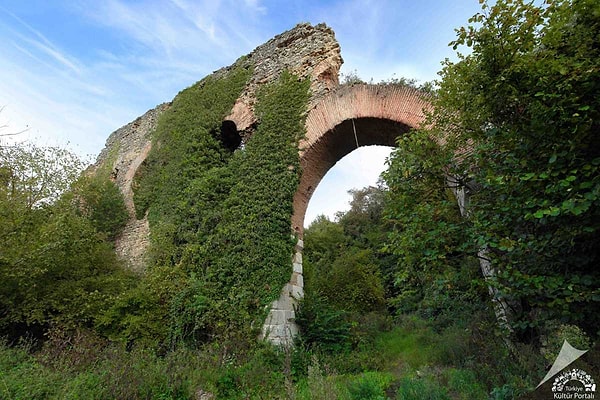
Bursa, besides being the first capital of the Ottoman Empire, draws attention with its water structures dating back to the Roman and Byzantine periods. Aqueducts were built in the city to meet the need for water, especially during the Orhangazi and Osman Gazi periods. The aqueducts in Bursa attract the attention of visitors with their architectural beauty and historical importance.
Transportation: Bursa is easily accessible in the city centre.
In the neighbourhood: Ulu Mosque, Green Tomb, Cumalıkızık Village.
Activities: Walking in the streets of the historical Bursa, resting in thermal facilities.
5. Pergamon (Bergama) Aqueducts

In the ancient city of Pergamon in the Bergama district of Izmir, there are aqueducts and water channels belonging to the Roman period. Some of the arches have survived to the present day and were used to meet the water needs of the city.
Transportation: The ancient city can be reached on foot or by car from the centre of Bergama.
In the neighbourhood: Ancient City of Bergama, Temple of Asclepion.
Activities: Exploring historical ruins, and nature walks.
6. Side Ancient Aqueducts
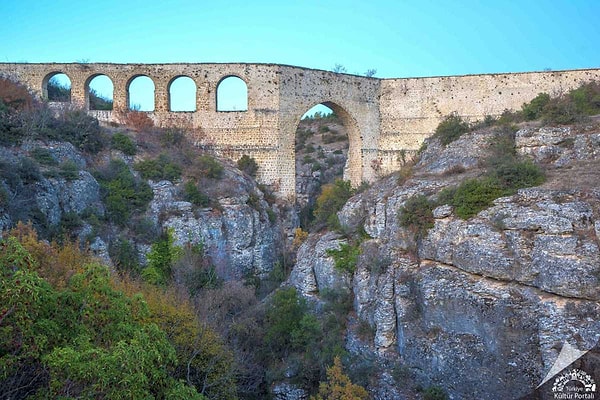
There are aqueducts dating from the Roman period in the Side district of Antalya. The ancient city of Side provided its water needs from the surrounding sources with these arches.
Transportation: It takes around 1 hour by car from Antalya centre to Side.
In the neighbourhood: Side Ancient Theatre, Temple of Apollo.
Activities: Enjoying the sea on the beach, an ancient city tour.
7. Kızılçullu Aqueducts (İzmir)
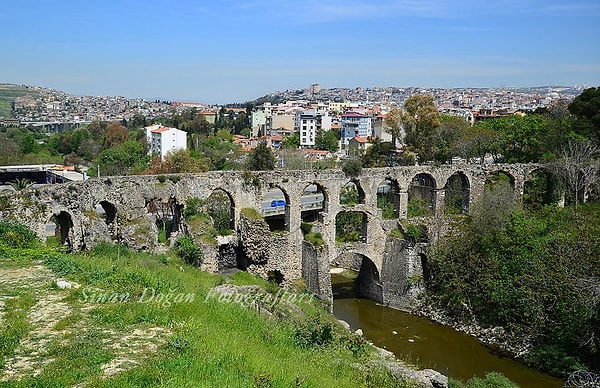
Kızılçullu Aqueducts, located in the Buca district of İzmir, are among the important historical water structures that have survived from the Roman and Byzantine periods. These arches, built to meet the water needs of Izmir (Smyrna) in ancient times, are part of a large system that carries water from the sources around the Gediz River. These arches, which were built especially on Kızılçullu Creek, were repaired and continued to be used in the Ottoman period.
The remains of the arches, which are still standing in Buca today, offer a unique sightseeing route for those who want to follow the route of historical waterways. Some parts of the structure contain remarkable details in terms of stone workmanship and arch architecture. These structures, known as 'Kızılçullu Aqueducts' among the local people, also establish a cultural connection with the Kızılçullu Village Institute in the region.
Transportation: Buca can be reached from the Izmir city centre by public transport or private car in a short time.
Places to see in the neighbourhood: Buca Pond, Sirinyer Park, Forbes Mansion, Hasan Aga Garden.
Activities: Nature walks, historical photography, cycling tours and exploring the urban history of Izmir.
Source: inizmir
Keşfet ile ziyaret ettiğin tüm kategorileri tek akışta gör!

Send Comment